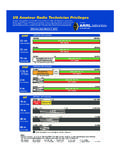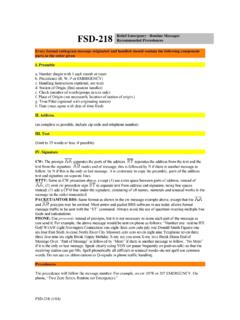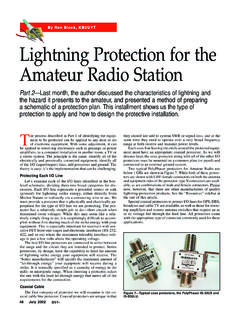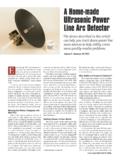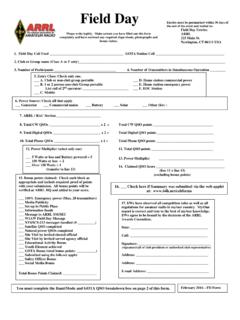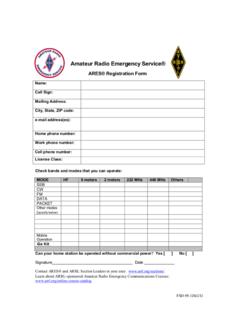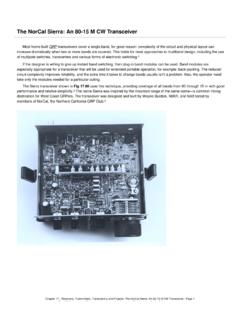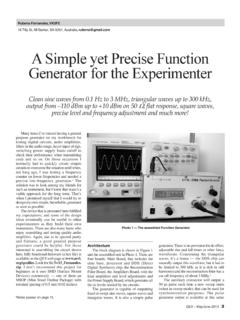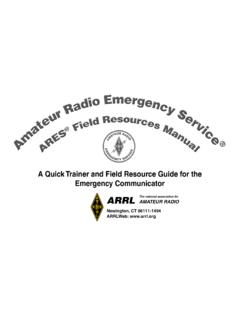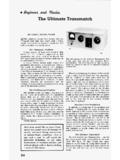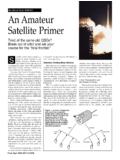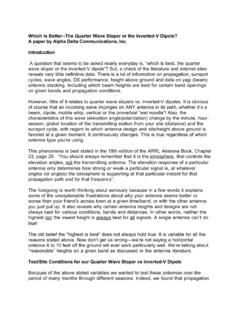Transcription of Radio Waves and the Ionosphere - American Radio Relay …
1 From November 1999 QST ARRLBy Ian Poole, G3 YWXadio propagation via the Ionosphere is a fascinating andimportant means of long-distance Radio of hams and commercial operators use theionosphere every day to make contacts over vast dis-tances. To effectively use these propagation modes to their fullest,however, we must understand the physics behind the magic. Know-ing when to listen, the best frequencies to use and where signalsmight come from enable experienced DXers to work stations whenless-experienced operators come up short.
2 In fact, knowledge ofpropagation and a feel for conditions and what each band mightproduce are valuable commodities for any Radio AtmosphereBefore we look at how signals are reflected by the ionospherewe must see where these reflections take place and how the re-flecting areas are formed. The atmosphere can be split into avariety of different layers according to their properties. The mostcommonly used names are shown in Figure 1. Here we can seethat the troposphere is the part of the atmosphere closest to theground, extending to a height of about 10 km.
3 At altitudes be-tween 10 and 50 km we find the stratosphere, which contains thefamous ozone layer at a height of about 20 shortwave communication the Ionosphere is the most im- Radio Waves and the IonosphereAlthough hams are required to have a passing familiarity with the physics of theionosphere, a more intimate understanding can make or break your enjoyment of thehobby. This primer will fill in some of the blanks and start you on a fascinating , although the troposphere plays a key role in VHF andUHF communication. The Ionosphere crosses several meteoro-logical layers and extends from about 50 to 650 IonosphereThe Ionosphere is so named because it is a region in the atmo-sphere where ions exist.
4 In most areas of the atmosphere moleculesare in a combined state and remain electrically neutral. In theionosphere, however, solar radiation (mainly ultraviolet light) is sointense that when it strikes gas molecules they split ionize andan electron is set free. What remains is a positive ion (a moleculethat is missing an electron) and a free electron. Although ionsgive their name to the region, free electrons actually affect radiowaves. The number of electrons starts to increase at an altitude ofabout 30 km, but the electron density isn t sufficient to affect radiowaves until about 60 often think of the Ionosphere as having a number of distinctlayers.
5 This is convenient for many explanations, but it s not en-tirely accurate as the entire Ionosphere contains ionized molecules(and free electrons). Instead, the layers are best thought of as peaksin ionization quickly identify the layers, peaks or regions, we refer tothem by the letters D, E and F. (There is a C layer, but its level ofionization is so low that it has no effect on Radio Waves .)LayersThe D layer is the lowest, at altitudes between 50 and 80 is present during the day when radiation is beaming in from thesun.
6 Because the density of the air is still high at this altitude,however, ions and electrons recombine relatively quickly. AfterRFigure 1 Areas of the 2 Typical electron distribution (day and night).From November 1999 QST ARRL sunset, when solar radiation is blocked by the Earth, electronlevels fall quickly and the D layer effectively the D layer, the next ionization level is called the Elayer. It can be found at altitudes between 100 and 125 km. Becauseelectrons and ions recombine relatively quickly here, ionizationlevels drop quickly after sunset.
7 Although a small amount of re-sidual ionization persists, the E layer virtually disappears at most important layer for long-distance communication isthe F layer. During the day it often splits into sub-layers we callF1 and F2, as shown in Figure 4. (At night the two layers mergeback into a single F layer.) F-layer altitudes vary considerablyand depend on the time of day, the season and the state of the the summer, the F1 layer may be at 300 km, with the F2 layerat 400 km or more. In the winter, these figures may be about300 km and 200 km, respectively.
8 At night, the F layer is gener-ally around 250 to 300 km. These figures vary considerably, how-ever, so consider them as with the D and E layers, ionization levels in the F layer de-crease at night. The rate of recombination is much slower, however,because the layer is higher and air density is much lower. Because theionization remains overnight, it can still affect Radio signalsThe Sun and the IonosphereIt s not surprising that solar variations affect the major factor is the number of visible sunspots. The spotsappear on the surface of the sun as dark (relatively speaking)areas that can be seen when an image of the sun is projected ontoa screen or a piece of paper.
9 Sunspots affect the ionospherebecause the areas around the spots emit greater amounts of theultraviolet radiation the main cause of : Never look directly at the sun, even through darkenedglasses. Doing so can permanently damage your number of spots varies, roughly conforming to an 11-yearperiod. This means that ionospheric conditions and Radio propa-gation vary in sync with this cycle. At the low point of the cycle,HF bands above 20 MHz or so may not support ionosphericpropagation. At or near the 11-year peak, frequencies at 50 MHzand higher may be and Sky WavesSignals in the medium and shortwave bands travel by twobasic means: ground Waves and sky Waves occur as the signal spreads out from the trans-mitter in all directions.
10 Instead of traveling in a straight line (andnot being heard beyond the visual horizon), Radio signal tends tofollow the curvature of the Earth. This occurs because currents areinduced in the surface of the Earth, which slows the wavefront nearthe ground. As a result, the wavefront tilts downward, enabling itto follow the curvature of the Earth and travel beyond the some exceptions, ground-wave propagation is generallyused for signals below 2 or 3 MHz. It is not used much at higherfrequencies because the level of attenuation increases with frequency,and above these frequencies coverage becomes progressively lessreliable.
